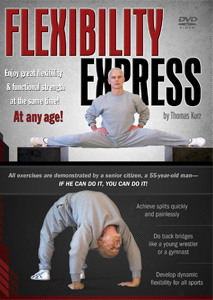by Thomas Kurz
In the preceeding articles (Questions and Answers on Strength Exercises and More Questions and Answers on Strength Exercises), I answered questions on the basic strength exercises—sit-ups, back extensions, deadlifts, and squats. My answers explained the reasons for building a foundation of strength with long sets of exercises using low resistance and—in the case of squats without additional resistance, such as Hindu squats—for doing the exercises at a lively pace. Both the high number of repetitions and the lively pace of movements benefit joints. This article does not explain why—I covered this topic in the previous article—but I will give a good example of joints other than the knees.
Russian geophysicist V. M. Khudyakov, has a herniated disc in his lumbar spine. He describes his experience in a letter to Fizkultura i Sport (number 10, 2002), a popular health and fitness magazine in Russia.
In 1994, Khudyakov spent a whole month in hospital because of the herniated lumbar disc. His pain subsided somewhat after the hospital stay. Self-administration of electroacupuncture also helped him, but he was still far from good health. (I do not go into details of this electroacupuncture treatment as such description would take me off the subject of this article, and besides, I do not give medical advice.) To fully recover, Khudyakov needed to strengthen the muscles supporting his spine. Eventually, he started to exercise when he was able. After a while his daily program looked like this:
5:00 a.m. sauna and bath in ice water followed by 40 to 45 minutes of exercise.
- 100 back extensions on the floor
- 100 forward bends, knees straight, putting hands on the floor
- 100 hip twists to the left and 100 to the right while sitting on a rotating wheel and keeping trunk immobile
- 100 trunk twists to the left and 100 to the right while keeping hips immobile
- 100 clockwise circles with the head and 100 counterclockwise circles
- 20 push-ups after each exercise
This program very quickly made him feel good, practically healthy, but his pain would return occasionally after prolonged work in bent posture while gold digging. (He had to go deep into the taiga to dig gold because he could not find a job in his town, his wife was laid off, and they had two little children.) Final recovery came later, he thinks because of increasing the number of repetitions in each exercise from 100 to 200 and the total number of push-ups on fingers to 180–200. Now he feels better than before his spine was injured.
Khudyakov does all these exercises in the morning, and in the evening he does 500 to 600 squats or alternates back extensions on the floor with leg lifts 300 times.
Lets turn now from the benefits of high repetitions to another important ingredient of exercise—deep breathing.
Moving in rhythm with deep breathing has the additional benefit of increasing levels of growth hormone. Growth hormone regulates the body’s metabolism of protein, carbohydrate, and fat. It stimulates growth and rebuilding of the body. In grown-ups, high (but not pathological) natural levels of growth hormone will not increase height, of course, but help rebuild the body after exercise.
Growth hormone promotes fat loss and muscle gain; it strengthens ligaments, bone, and joint cartilage and even thickens the skin. While the European strongmen of old and Chinese wise men did not know the connection between deep breathing during exercise, growth hormone, and other local growth factors, they knew that deep breathing makes exercise more effective—giving more strength, stamina, and health benefits than exercising with shallow breathing.
Increasing growth hormone levels through unnatural means and without exercise gives poor results and bad side effects. For example, injecting growth hormone causes muscles to grow bigger but mushy and weak and joints to become painful. Other methods of injecting (more effective) or ingesting (less effective) “growth hormone releasers,” such as the amino acid arginine, are not as effective as high-intensity or high-volume exercise with short rest breaks.
If you have any questions on training you can post them at Stadion’s Sports and Martial Arts Training Discussion Forum



